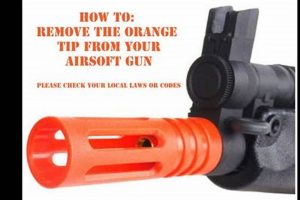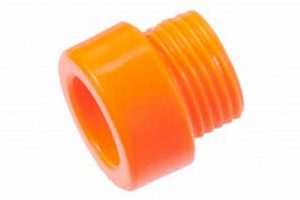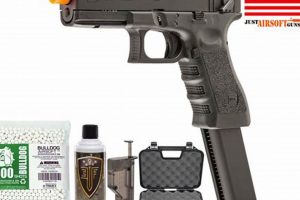The presence of a brightly colored tip, often orange, on airsoft guns serves as a visual indicator that distinguishes them from real firearms. This marking aims to prevent misidentification, especially by law enforcement or the general public. For example, an airsoft replica of a handgun may feature a blaze orange tip affixed to the barrel.
This visual differentiation is crucial for public safety and preventing accidental escalation. Historically, the absence of such markings led to confusion and potentially dangerous situations where airsoft devices were mistaken for actual firearms. The practice helps to minimize the risk of misuse or unintended consequences associated with realistic-looking replica weapons.
The following sections will elaborate on the legal requirements, accepted practices, and specific circumstances surrounding the utilization of such safety markings on airsoft equipment.
Guidance Regarding Airsoft Gun Identification
The following recommendations pertain to the safe handling, transportation, and modification of airsoft devices to mitigate potential misunderstandings and legal ramifications.
Tip 1: Verify Local and Federal Regulations: It is imperative to research and comply with all applicable laws concerning airsoft guns in the specific jurisdiction of use and transit. These regulations can vary significantly.
Tip 2: Maintain the Required Marking: If local regulations stipulate a specific color or marking, ensure the airsoft device retains that identification. Altering or removing a legally mandated marking can result in penalties.
Tip 3: Transport Responsibly: When transporting an airsoft gun, keep it stored in a case or container that obscures its appearance. This reduces the likelihood of alarming the public.
Tip 4: Avoid Public Display: Refrain from brandishing or displaying an airsoft gun in public areas. Doing so can cause undue alarm and potentially lead to interaction with law enforcement.
Tip 5: Secure During Storage: When not in use, store airsoft guns securely, out of reach of children and unauthorized individuals.
Tip 6: Exercise Caution During Modifications: Any modifications to the appearance of an airsoft gun should be carefully considered in light of local regulations and potential safety implications.
Tip 7: Communicate Awareness: Educate individuals who may handle or encounter the airsoft device about its non-lethal nature and the importance of responsible handling.
Adherence to these guidelines promotes safe practices and minimizes the risk of misidentification, ensuring a more secure environment for all.
The subsequent section will provide a comprehensive conclusion summarizing the crucial elements related to this topic.
1. Federal Law
Federal law plays a pivotal role in regulating the appearance of imitation firearms, including airsoft guns. The specific requirements are intended to ensure these replicas are readily distinguishable from actual weapons, mitigating potential risks associated with misidentification.
- 15 CFR 1150.2 – Marking of Toy, Look-Alike and Imitation Firearms
This section of the Code of Federal Regulations mandates that all toy, look-alike, and imitation firearms, including airsoft guns, be marked with a blaze orange plug inserted in the barrel, or displayed with conspicuous orange coloration affixed to the exterior surface of the barrel. This marking is a visual cue designed to prevent confusion with genuine firearms during manufacture and initial distribution.
- Enforcement and Penalties
The Department of Commerce is responsible for enforcing the federal marking requirements. Failure to comply with 15 CFR 1150.2 can result in civil penalties, including fines, imposed on manufacturers, distributors, and importers who fail to adhere to the orange marking mandate. This facet highlights the federal government’s commitment to enforcing this law.
- Exemptions and Exceptions
Federal law does outline certain exemptions to the marking requirement, primarily concerning specific historical replicas or devices intended for theatrical or training purposes, provided they are used in controlled environments and not readily accessible to the general public. These exemptions are narrowly defined and do not typically apply to standard airsoft guns intended for recreational use.
- Preemption and State Laws
While federal law establishes a baseline standard for marking, it does not necessarily preempt stricter state or local regulations. States and municipalities are permitted to enact more stringent requirements regarding the appearance or handling of airsoft guns. Therefore, compliance with federal law does not guarantee compliance with all applicable laws.
In summary, federal law dictates a mandatory orange marking for airsoft guns to facilitate immediate visual differentiation from real firearms. However, adherence to federal statutes alone does not ensure complete legal compliance, as state and local ordinances may impose additional or more restrictive regulations.
2. State Regulations
State regulations concerning airsoft guns build upon and often extend beyond federal mandates. These laws address various aspects of airsoft gun ownership, use, and appearance, frequently impacting requirements for safety markings.
- Mandatory Coloration Beyond Orange
Several states stipulate that airsoft guns must possess coloration beyond the federally mandated orange tip. This can include requiring the entire airsoft gun to be brightly colored, or specifying certain percentages of the surface area that must be painted in highly visible hues. Such requirements aim to enhance visibility and differentiation from real firearms, reducing the risk of misidentification.
- Age Restrictions and Purchase Limitations
Many states impose age restrictions on the purchase and possession of airsoft guns. These restrictions often link directly to the display of orange tips or other markings, as the presence of these identifiers might influence whether a minor can legally purchase or possess an airsoft device. The rationale is that clearly identifiable airsoft guns are less likely to be misused by underage individuals.
- Public Display and Brandishing Laws
State laws frequently address the public display or brandishing of airsoft guns, irrespective of the presence of an orange tip. Some jurisdictions prohibit displaying airsoft guns in public altogether, while others permit it only if the device is clearly marked and carried in a manner that minimizes public alarm. This underscores the importance of considering both the marking and the manner of handling when using airsoft devices in public spaces.
- Transportation and Storage Requirements
States may also regulate the transportation and storage of airsoft guns, often mandating that they be kept in cases or containers when not in use. While the presence of an orange tip does not negate these requirements, it may influence the degree of scrutiny applied by law enforcement during transportation. A clearly marked airsoft gun, properly stored, is less likely to be perceived as a threat compared to an unmarked device.
These state-level regulations underscore the variable legal landscape governing airsoft gun usage. While federal law establishes a baseline, individual states often implement stricter requirements, particularly concerning the visibility and handling of these devices in public. Therefore, it is crucial to consult the specific laws of the relevant state to ensure full compliance.
3. Public Safety
The utilization of a brightly colored tip on airsoft guns is inextricably linked to public safety. The primary function of this visual marker is to allow immediate differentiation between an airsoft replica and a genuine firearm. This distinction is vital in preventing potentially dangerous misinterpretations by law enforcement and civilians. The presence of the orange tip serves as an initial indicator, mitigating the risk of an armed response based on a mistaken perception. For instance, an individual carrying an airsoft gun with the required marking is less likely to be subjected to immediate, potentially lethal force by law enforcement compared to someone carrying an unmarked replica.
The absence of a mandated visual identifier introduces a heightened risk of misidentification. Real-world incidents demonstrate that unmarked airsoft guns have been mistaken for actual firearms, leading to confrontations with law enforcement and, in some cases, tragic outcomes. This underscores the practical significance of the marking, regardless of individual opinions regarding its aesthetic impact. Moreover, adherence to marking requirements promotes responsible ownership and fosters a culture of safety among airsoft enthusiasts, reducing the likelihood of accidental harm or misuse.
The ongoing challenge lies in balancing the realistic appearance desired by airsoft participants with the paramount need for public safety. While some may view the orange tip as an unnecessary intrusion, its role in preventing misidentification and potential harm cannot be overstated. Continuous education, consistent enforcement of regulations, and ongoing collaboration between law enforcement, manufacturers, and the airsoft community are crucial to upholding these safety standards and minimizing potential risks.
4. Transportation Rules
The intersection of transportation rules and safety markings for airsoft guns reveals a critical aspect of responsible ownership and legal compliance. Transportation rules dictate how airsoft guns must be carried when not in use, typically mandating that they be concealed within a case or container. The presence of an orange tip, while primarily intended for visual identification, directly impacts the degree of scrutiny applied during transport. An airsoft gun with a visible orange tip, transported openly but legally, still invites potential interaction with law enforcement or the public. Conversely, an unmarked airsoft gun, even if transported legally in a closed container, could lead to more severe consequences if discovered during a traffic stop or security check, due to the immediate risk of misidentification as a real firearm. Some jurisdictions may reduce penalties if the orange tip is in place.
The function of the orange tip during transportation shifts from immediate visual identification to a preventative measure against escalated responses. While the device is concealed, the marking serves as a defense against worst-case scenarios. For instance, consider a hypothetical incident where a vehicle is searched, and an airsoft gun is discovered. If the device lacks the required marking, law enforcement may initially perceive it as a genuine weapon, potentially leading to an armed response and subsequent legal ramifications. However, if the airsoft gun has the orange tip, it offers a visual indicator confirming its non-lethal nature, possibly de-escalating the situation and mitigating potential penalties. This is due to the device being considered toy firearm, versus a true deadly weapon.
In conclusion, while transportation rules focus on concealment, the presence of the marking on an airsoft gun remains vital even when the device is not visible. It provides a safeguard against misidentification during unforeseen circumstances, reduces the potential for escalated reactions, and reinforces the owner’s commitment to responsible practices. Understanding this connection is essential for all airsoft gun owners, promoting safety and ensuring compliance with applicable laws.
5. Display Restrictions
Display restrictions concerning airsoft guns are inextricably linked to the presence, or absence, of mandated safety markings. Regulations governing the visible presentation of airsoft devices aim to prevent public alarm and reduce the potential for misidentification as genuine firearms. The presence of a blaze orange tip often influences the stringency of these restrictions; a clearly marked airsoft gun may be subject to less restrictive display rules than an unmarked replica. Jurisdictions often prohibit openly carrying airsoft guns that lack identifiable markings in public areas, while allowing properly marked devices to be transported in specific circumstances, such as directly to or from a designated airsoft field. The rationale is that a clearly identifiable airsoft gun poses a reduced perceived threat to public safety.
The interaction between display restrictions and mandated markings extends to retail environments. Many retailers are required to display airsoft guns in a manner that emphasizes their non-lethal nature, such as behind counters or within locked cases. The presence of an orange tip assists in complying with these requirements, reinforcing the understanding that the item is not a real firearm. Instances where retailers fail to adhere to these display protocols and sell unmarked airsoft guns have resulted in legal action, highlighting the importance of consistent enforcement. Furthermore, educational programs aimed at responsible airsoft ownership often emphasize the importance of understanding and adhering to both marking requirements and display restrictions to prevent accidental misidentification and misuse.
Therefore, display restrictions serve as a practical component of an overall strategy aimed at mitigating the risks associated with airsoft guns. By limiting their visible presentation and linking permissible display to mandated safety markings, regulatory bodies seek to minimize public alarm and prevent the mistaken perception that these devices are genuine firearms. This interconnectedness underscores the importance of understanding and complying with both the specific regulations pertaining to safety markings and the broader restrictions governing how airsoft guns can be displayed in public and retail settings.
6. Modification Impact
Alterations to an airsoft gun’s original configuration can significantly affect its legal status, particularly concerning mandated safety markings. Modifications that obscure, remove, or alter required markings may result in non-compliance, potentially leading to legal consequences.
- Removal or Obscuration of the Orange Tip
The deliberate removal or obscuration of a mandated orange tip, or any other required safety marking, constitutes a violation of applicable regulations. This action can expose the owner to fines, confiscation of the airsoft gun, and potential criminal charges, depending on the jurisdiction. For example, painting over an orange tip with a darker color is considered a violation of the marking requirement.
- Cosmetic Modifications Mimicking Real Firearms
Modifications intended to make an airsoft gun appear more like a real firearm can have legal ramifications, even if the orange tip remains intact. If the modifications create a device that is virtually indistinguishable from a real firearm, it may be subject to stricter regulations governing actual firearms. This could involve licensing requirements or restrictions on possession. Converting the handle to a wood or metal material can potentially break the rule.
- Performance Enhancements and Legal Status
Performance-enhancing modifications that increase the velocity or power of an airsoft gun may alter its legal classification. Some jurisdictions have specific velocity limits for airsoft guns, and exceeding these limits may reclassify the device as a more regulated item, irrespective of the presence of the orange tip. Increasing the speed of the projectile through upgrades can result in a violation.
- Impact on Resale and Transfer
Modifications can affect the legal status of an airsoft gun when resold or transferred to another owner. If the modifications render the device non-compliant with applicable regulations, the seller or transferor may be liable for any resulting violations. The modified devices should not be transferred unless it returns to the original state to ensure all compliance.
Modifying an airsoft gun carries legal implications. Compliance with marking requirements extends beyond the initial purchase. Any alterations must be carefully considered in light of applicable regulations to ensure the modified device remains compliant. Failure to do so can result in penalties and legal liabilities. The marking is the primary visual element but modifications can lead to other issues.
Frequently Asked Questions
This section addresses common inquiries regarding the legal requirements and practical considerations surrounding the use of orange tips and other safety markings on airsoft guns.
Question 1: Is an orange tip universally required on all airsoft guns in the United States?
Federal law mandates an orange tip, or similar conspicuous marking, on all airsoft guns during manufacture and importation. However, state and local laws may impose additional or more stringent requirements.
Question 2: Can an orange tip be legally removed after purchasing an airsoft gun?
Removing a mandated orange tip is generally illegal and can result in penalties. State and local regulations often prohibit altering or removing required safety markings.
Question 3: What are the potential consequences of possessing an airsoft gun without a required orange tip?
Possessing an airsoft gun lacking a mandated orange tip can lead to fines, confiscation of the device, and potential criminal charges, depending on the applicable laws and the specific circumstances.
Question 4: Does the presence of an orange tip guarantee legal compliance in all situations?
No, the presence of an orange tip does not guarantee legal compliance. Additional regulations may govern the handling, transportation, storage, and public display of airsoft guns, regardless of the marking.
Question 5: Are there exceptions to the orange tip requirement for certain types of airsoft guns?
Federal law provides limited exceptions for historical replicas or devices used in controlled environments, such as theatrical productions. However, these exceptions are narrowly defined and rarely apply to standard airsoft guns used for recreational purposes.
Question 6: How does the orange tip contribute to public safety?
The orange tip serves as a visual indicator that distinguishes airsoft guns from real firearms, reducing the likelihood of misidentification and potential confrontations with law enforcement or the public.
Adherence to both federal and local regulations regarding safety markings is essential for responsible airsoft gun ownership. Failure to comply can result in serious legal repercussions.
The subsequent section will provide a comprehensive conclusion summarizing the crucial elements related to this topic.
Conclusion
The preceding analysis demonstrates that the requirement for a blaze orange tip on airsoft guns is a multifaceted legal and safety issue. While federal law mandates such markings during manufacture and importation, state and local regulations introduce further complexities. Compliance with these regulations is paramount for responsible ownership and mitigating potential risks associated with misidentification and misuse.
The presence of the marking serves as a visual cue, distinguishing airsoft guns from genuine firearms. This is vital for public safety and preventing potential escalations by law enforcement or alarmed citizens. Therefore, adherence to both federal and local ordinances is not merely a matter of legal compliance, but also a responsibility towards ensuring a safer environment. Continued vigilance, education, and adherence to legal standards are essential within the airsoft community.







